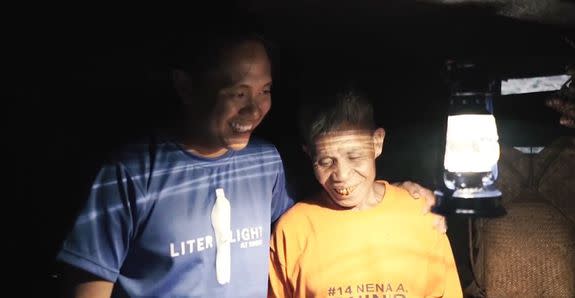Plastic bottles are bringing light to the poorest parts of world

A project called 'Liter of Light' is hoping to bring light to places that need it most, by using DIY lamps made from plastic bottles. Mashable caught up with the founder of the project to hear how it works and find out who can benefit.
One of the immediate impacts of a natural disaster, like the hurricane that recently wreaked havoc in Haiti, is that it's often followed by darkness. It takes months for aid, and in this case light, to reach the most remote places.
On a daily basis, more than 1.5 billion people face similar darkness, or at best the dim glow of candlelights or kerosene lamps, whose fumes are poisonous.
Some of these communities are extremely remote and have no access to electricity. Others have access to electricity, but opt out of using it because it's so expensive.
The problem goes far beyond the lack of light. It extends to long-term issues about security, independence, health and access to education.
An open source project called 'Liter of Light' is trying to change this by using plastic bottles to make simple solar-powered lights.
SEE ALSO: Crystal ball-like robot will fill your home with sunlight

Image: Liter of light
How it works
Plastic bottles are filled with water and bleach, which eliminates algae from turning the water green. The bottles are then installed into roofs of houses and begin working as a mirror on the roof, refracting the light in 360 degrees and offering a natural light bulb during the day.
"You go to a village and you say, 'Who wants an almost free source of light during the day?', founder Illac Diaz told Mashable. "We come back to the villages two months later and we say to the locals, 'Look, with the money that you have saved from not using your electricity, candles or kerosene lamps (around $10-$15 a month), would you like to upgrade your device to light up during the night?".
A microcosm of entrepreneurs
The project then offers the parts needed to make the simple solar-powered lights to women and teaches them how to assemble them.
"We give them parts (all locally available) for ten lamps. They have to assemble them all by hand, down to the very basics of making copper strips into circuits. This way they learn, in the long run, how to make these repairable solar lights with local parts and local skills."
The project lends parts to local people, which they pay back once they start making money from selling the lamps, as opposed to bringing the product from abroad and asking people to sell it.
One village at a time
Three years ago 'Liter of Light' was illuminating rooms and houses. Now it plans to light up entire villages, create public lighting systems using cheap and sustainable solar power methods. More than 650,000 of these lights are already in place in around 20 countries.
How much it costs
A basic plastic bottle solar lamp costs around $3. You can also trade in your kerosene lamp to be fitted with a solar lamp for about $5. Street lamps go for about $25 to $30. The more powerful lamps sell for as much as $60. But as Diaz says, compared to other solar-powered lights, which cost about $1,000, this is very affordable.

 Yahoo News
Yahoo News 